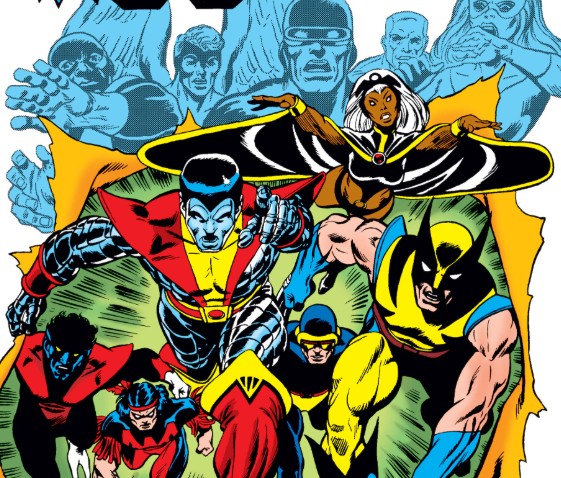


Fifty years ago, Marvel Comics was in a somewhat troubled period. The 1970s were a decade mired in inflation, paper shortages, and editorial turnover. After Stan Lee retired from monthly scripting, many of his titles were turned over to Roy Thomas and other successors. Over time, sales were unable to keep up, and comics became increasingly reliant on advertisements. While a typical superhero comic story from the 60s or 80s would run 22 pages, the 1970s experienced continual price hikes and declining quantity of story pages, with Marvel and DC often running only 17 pages of story until well into 1980. One of the first fatalities over changes in the comics market was the X-Men. Despite a run with art by star artist Neal Adams, the original X-Men eventually lapsed into a period of reprints. Throughout the first half of the 70s, their new appearances were infrequent, making occasional appearances in comics like Steve Englehart’s Secret Empire saga in Captain America. There was even an experiment with having them go into action without a costume in an early issue of Marvel Team-Up, which seemed to be Marvel’s reaction to the experiments in plain clothes superheroes by Mike Sekowsky on DC’s Wonder Woman and Metal Men. Other than the now fur covered Beast’s brief run in Amazing Adventures, however, the X-Men were largely absent as stars of their own new stories for much of the 1970s. This all changed with Giant-Size X-Men #1.
To offset the limited story pages in their main titles, Marvel was experimenting with higher page count quarterly supplements to popular titles like Spider-Man, Avengers, Defenders, and Fantastic Four, setting the precedent for Marvel’s later use of quarterlies like X-Men Unlimited. By far, the most significant Giant-Size issue of this era is Giant-Size X-Men #1.
This issue featured the familiar original team of Beast, Cyclops, Iceman, Angel, and Marvel Girl, and later 60s additions Havok and Polaris, trapped on a sentient island called Krakoa. As Xavier gathers a team to rescue them, we are introduced to a number of new mutants as well. Most popular of these would be Wolverine, a repurposed Hulk opponent from the run by Len Wein and Herb Trimpe. This mysterious character who had appeared in a battle with Hulk and Wendigo in Canada was tapped by Wein to be in his relaunch of the long-dormant X-Men team. Former X-Men villains Banshee from Ireland and Sunfire from Japan also return as new X-Men. Other additions were entirely new: Colossus, a Russian farmer who can turn his skin into metal; Nightcrawler, a teleporting mutant whose demonic appearance led to his persecution in Germany; Thunderbird, a short lived addition to the team from a Native American tribe; Storm, an African mutant with weather manipulation powers who was worshipped as a goddess.

While the original story ends happily with the original X-Men saved and Krakoa blasted into space, later stories reveal what we were initially told was not the full truth. Over the years, a number of revamped versions of this story like the 1980s reprint Classic X-Men #1 by Chris Claremont see publication. In the 2000s, Deadly Genesis by Ed Brubaker revealed that Xavier had attempted a previous rescue operation, even involving Scott’s long-rumored third brother, only for most of the team to die. After sporadic appearances in stories like the “Son of Krakoa” gag issue in Excalibur, the island regained its full prominence in the run of Jonathan Hickman as the latest mutant utopia sanctuary.
Following the success of Giant-Size X-Men, a decision was made to relaunch the main title as a feature for new stories. Artist Dave Cockrum carried over to the main book, continuing to develop new characters like the Shi’ar Imperial Guard from his old DC plans for new Legion of Super-Heroes costumes. Claremont’s run brought the X-Men a supporting cast from across the universe like Lilandra the Shi’ar majestrix and Lila Cheney the space rocker, as well as down to earth characters like young mutant Kitty Pryde and her dance instructor Stevie Hunter.

Claremont’s run is among the longest and richest in comics, continuing for fifteen years until the relaunch of the X-Men titles after their battle with the Shadow King on the Muir Island Saga. By the early 90s, the landscape had significantly changed. The Bronze Age’s increased focus on characterization and writer dominated books shifts strongly to editor and artist driven titles with the ascent of the Image founders Rob Liefeld and Jim Lee. Claremont felt he was losing control despite his efforts to silo the X-Men in far off locales like Australia and the United Kingdom. Claremont’s experiments deconstructed the team, scattering them around the world with amnesia through the Siege Perilous. While characters like Nightcrawler and Kitty Pryde spent a decade apart from the X-Men in Excalibur, their eventual return to the fold shows the staying power of the Bronze Age X-Men.
Later writers like Scott Lobdell struggled to recreate Claremont’s long-term plotting methods, resulting in divisive improvised storylines like Onslaught. Eventually Claremont would return for another run in the early 2000s, using many of the same characters as well as incorporating new members like Tessa from the Hellfire Club and a new version of Thunderbird. His contributions to the X-Men remain vast, laying the foundation that allowed the X-Men to go from one of Marvel’s weakest sellers to one of its strongest. Through cosmic and emotional storylines like the Dark Phoenix Saga, Claremont’s X-Men were able to reach levels of popularity that may never able to be matched. His run set the precedent for even DC’s lengthiest and most character driven team comic runs including Marv Wolfman and George Perez’s New Teen Titans and Paul Levitz and Keith Giffen’s Legion of Super-Heroes.
Have you read Giant-Size X-Men #1? Did you prefer the original five or the second generation of X-Men?
Discuss this article on the Toonzone Forums!
The post Giant-Size X-Men #1: A 50th Anniversary Retrospective appeared first on Anime Superhero News.